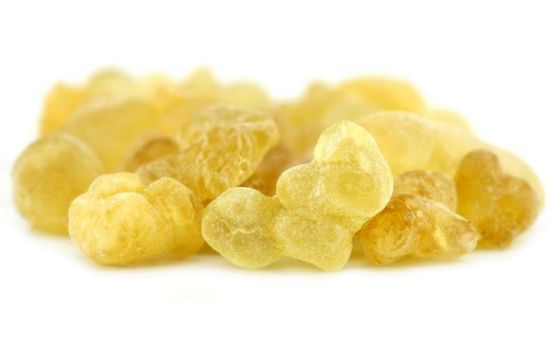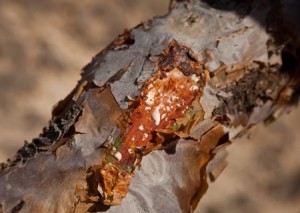Frankincense Alternative Cancer Treatment: Your Complete Guide

Frankincense is a hard, resinous material made from the sap of the Boswellia tree, which is native to the mountainous regions of India, Northern Africa and the Middle East. Numerous types of Boswellia trees contain the particular sap used to make frankincense, including Boswellia Sacra (aka Boswellia carteri, Boswellia thurifera, Boswellia bhaw-dajiana), Boswellia Frereana, and Boswellia Serrata. This ancient medicine has been used for thousands of years to treat arthritis and inflammatory conditions, and is now being rediscovered by modern scientists to have potent anti-cancer effects.
In much the same way that maple trees can be tapped to make maple syrup, and pine trees can be tapped to make turpentine (both of which have powerful medicinal properties), by making an incision in the trunk of the Boswellia tree, an oily gum-resin will leak out and can be used to make Frankincense. Once the sap is collected from the tree, Frankincense is made by removing the oil and solidifying the remaining resin.
The name frankincense is derived from old french “franc encens”, meaning high quality incense, so it can be burnt for its aroma or ingested for other medicinal benefits.
TABLE OF CONTENTS
Properties of Gum-Resin from the Boswellia Serrata Tree
 In a review published on The National Library of Medicine, researchers explain that the gum-resin from the Boswellia Serrata tree contains 30-60% resin, 5-10% essential oils, and the remainder consists of sugar.
In a review published on The National Library of Medicine, researchers explain that the gum-resin from the Boswellia Serrata tree contains 30-60% resin, 5-10% essential oils, and the remainder consists of sugar.
The Resin
The resin component of Boswellia serrata contains:
- Monoterpenes
- Diterpenes
- Triterpenes
- Tetracyclic triterpenic acids
- Four pentacyclic triterpenic acids: β-boswellic acid, acetyl-β-boswellic acid, 11-keto-β-boswellic acid and acetyl-11-keto-β-boswellic acid. Out of these four boswellic acids, acetyl-11-keto-β-boswellic acid is the most potent inhibitor of pro-inflammatory enzymes.
Some studies in the scientific literature use extracts from the Boswellia serrata resin, some use essential oils, and some even use extracts from the leaves of the tree and tests their efficacy against cancer cells. The cutting edge research is summarized below.
16 Studies on Frankincense vs Cancer
- Since patients diagnosed with pancreatic cancer have less than a 5% chance of surviving more than 5 years, researchers from Shanghai, China investigated how to produce the most potent medicine from boswellia gum resin, and the effect their frankincense essential oil had on cultured human pancreatic cancer cells. “All fractions of frankincense essential oil from Boswellia sacra are capable of suppressing viability and inducing apoptosis of a panel of human pancreatic cancer cell lines,” the study concluded.
- A fascinating study in 2013 took a gum resin extract from the Boswellia serrata and encapsulated it in a lipid layer in an attempts to enhance its anti-cancer potential. Basically what this lipid layer does is it makes the medicine more easily absorbed and transported inside cells since they also have lipid outer layers. The frankincense extract encapsulated within a lipid layer “showed significantly higher cytotoxic/antitumor potential” than without a lipid layer. More specifically, in both cell cultures (in vitro) and in living organisms (in vivo), the lipid-encapsulated frankincense extract was 40-60% more toxic to cancer cells! (PMID:23237302)
- In 2014, researchers at Ulm University in Germany isolated α-acetoxy-tirucallic acid from the Boswellia gum resin examined its effect on cancer cells. The study found that α-acetoxy-tirucallic acid unleashed a storm of oxidative stress on cancer cells, with no toxic effects to healthy cells whatsoever. For those interested in a technical explanation, the isolate from Boswellia gum resin “induced loss of cell membrane asymmetry, caspase-3 activation, and DNA fragmentation in vitro and in vivo”. (PMID:25316122)
- An alcohol extract of the gum from the Boswellia thurifera was used on cultured human breast cancer cells to test its effects on p53 gene expression. Defective p53 gene expression is said to allow abnormal cells to proliferate, resulting in cancer. The results of this study indicate that the extract generated P53 gene expression “significantly more in treated cancer cells than untreated cells.” In addition to stimulating the defective gene in the cancer cells (that permitted the cancer to grow in the first place), researchers admitted that the gum extract also induced “toxicity in the cultured breast cancer cell line.” (PMID:25237368)
- A 74-year-old man who was diagnosed with bladder cancer that travelled and began forming new tumors in both of his lungs. After refusing chemotherapy, he was treated instead with a number of Korean herbal medicines, including frankincense from the Boswellia carteri tree. “The size and number of multiple metastatic nodules in both lungs were markedly decreased and the symptoms had disappeared,” concluded the study.
- Frankincense was put to the test along with the herb Sandalwood to assess the ability of both medicines to induce cell death in cultured human bladder cancer cells. According to the study authors, the frankincense essential oil killed cancer cells by unleashing a storm of free radicals inside the cells, all without harming healthy cells. The sandalwood also killed cancer cells, but in a different way altogether.
- This study used an extract from leaves of the Boswellia ovalifoliolata to evaluate their ability to destroy the difficult-to-treat Triple Negative Breast Cancer (TNBC) cells. The scientists found that their leaf extract was toxic to cancer cells, and also weakened cancer cells to make chemotherapy more effective.
- Researchers at Shandong University, China examined the effect of a derivative of Boswellia serrata gum resin on human gastric cancer. The extract used in the study was called Acetyl-11-keto-beta-boswellic acid or AKBA for short, and according to researchers it “exhibited anti-cancer activity in vitro and in vivo” without toxicity to healthy cells. (PMID:23237302)
- What happens when you treat 3 types of cultured human breast cancer cells with essential oil extracted from boswellia gum resin? In the study, the frankincense essential oil showed cancer-cell specific toxicity in all 3 breast cancer cell lines, and the researchers even suggested that it “may even be effective for advanced breast cancer”.
- Scientists from the University of Texas conducted a study in 2011, examining a gum resin derivative of Boswellia serrata on human pancreatic tumor cells, and also in mice with pancreatic cancer. In the in vitro trials with the cultured human pancreatic cancer cells, the frankincense extract inhibited proliferation and caused cancer cell death in 4 human pancreatic cancer cell lines. In the nude mice trials, the frankincense extract “significantly inhibited the tumor growth”. (PMID:22066019)
- Another study published in 2012 used a gum resin extract from Boswellia serrata on mice with colorectal cancer tumors implanted inside them. The scientists found that the oral administration suppressed the growth and spread of cancerous tumors in the laboratory mice.
- Boswellic acid was tested for its anti-cancer potential in tumor-bearing mice in 2011. Results of the study indicated that the Boswellic Acid significantly inhibited the tumors, reducing the overall solid tumor weight and increasing the survival of the mice. (PMID:21513768)
- The results of a 2011 study conducted in New Jersey at Rutgers University revealed “that beta-boswellic acid and its derivatives (the major constituents of Boswellin) have anti-carcinogenic, anti-tumor, and anti-hyperlipidemic activities.”
- When human bladder cancer cells were treated with Frankincense oil derived from Boswellia carteri, the oil suppressed bladder cancer cell viability without harming healthy bladder cells, concluded study researchers. (PMID:19296830)
- A Boswellia serrata gum resin extract induces apoptosis in cancer cells, and researchers from India investigated this extract to find out how it encourages cancer cells to commit suicide. The study demonstrated that the cancer cell death was a result of the frankincense extract producing free-radical induced oxidative-stress within the cancer cells. (PMID:17636381)
- Bonus! Although this one is not cancer related, if you’re a woman you will be happy to read about this next experiment. A study examined “a base cream containing 0.5% BAs [Boswellic acid] in the treatment of clinical manifestations of photoaging of facial skin with a randomized, double-blind, placebo-controlled, split-face study.” The fifteen female volunteers applied the Boswellic acid-containing cream to half of their face once each day, and after 30 days significant improvements were observed, including a decrease in tactile roughness, fine lines, and blackhead-causing sebum along with an increase in skin elasticity. (PMID:20136919)
3 Cancers Cured with Frankincense Essential Oil
- Fibroid Tumors – A woman named Deb Cattan from Colorado wrote in 2007: “I started getting fibroid tumors in my 40’s and in my 50’s starting trying some things to get rid of them. I had one on my shoulder and combined taking BetaGlucans and applying Frankincense essential oil directly. It started shrinking within days and within a few weeks was almost completely gone. This is amazing and feels great to have it gone!”
- Skin Cancer – In 2005, Darlene Cox treated skin cancer on the side of her face with frankincense essential oil. Here’s what she had to say: “I deliver mail in the hot Florida sun, and from that I get small skin cancers, on the right side of my face. I used frankincense on it every morning and night for a week, and it was gone. Yes it comes back every now and then, but that is to be expected, doing what I do to make a living. As long as there are oils to treat just about anything and everything, I will continue to deliver that mail!”
- Skin Cancer – Carol Boczarski from Georgia USA wrote of her friend’s experience with Frankincense essential oil on skin cancer. “A dear friend of mine was caring for an elderly lady who had a patch of skin cancer on her face. When she applied a high quality, therapeutic grade essential oil of Frankincense (she had tried a cheap brand of Frankincense prior), the spot on her face cleared up and healed within 2 days.”
Conclusion
In addition to it’s potent cancer cell killing properties, Frankincense acts as a potent anti-inflammatory and immune system boosting medicine in the body and can likely benefit any disease or condition. To use for health maintenance, a cycle of Frankincense supplementation can be ingested every couple of months to keep the immune system strong and optimize overall body function.
Resources Used:

